


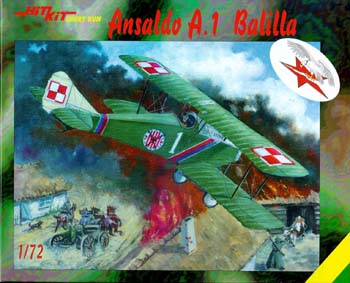 HIT
KIT 1/72 ANSALDO A-1 BALILLA
HIT
KIT 1/72 ANSALDO A-1 BALILLA
by Michael Kendix
Background
During World War One, the Italian air force, the Aeronautica del Regio Esercito, gave an extremely good account of itself, fighting its opponents effectively and gaining air superiority by the beginning of 1918.
Bombing units were equipped with excellent aircraft of Italian design; for example, the famous Caproni multi-engined bombers and the SVA-5 long range single-seaters. Fighter squadrons, conceived of by Giulio Douhet, commander of the Battaglione Aviatori, as early as 1913, were mainly equipped with aeroplanes of foreign design, most of which were built under license by Societi Anonima Nieuport Macchi of Varese.
In 1917, Ansaldo produced the first prototype of the A-1 type, a single-seat biplane built for fighting duties. It was designed by Ing. Brezzi, with assistance from Luigi Olivari, at that time the Italian ace of aces. Named 'Balilla' after the popular young Italian patriot of the Nineteenth Century, it was developed from the excellent SVA reconnaissance machine. The latter was, most probably, the first aircraft to be designed using a truly scientific approach. The A-1 was smaller than its illustrious predecessor, although it retained the same fuselage layout and engine. Four Ansaldo A-1s, serialled 16550, 16555, 16556 and 16558, were used by the 70a Squadriglia from August 1918, the latter was flown by Ten. Leopoldo Eleuteri on October 3rd, 1918, when he shot down an Austrian Albatros fighter. Fast and well armed for its time, the 'Balilla' was also assigned to the famous 91st Squadriglia, the 'Aces Squadron', but it arrived too late to be employed on a large scale before the end of World War One.
After the war, several examples of the 'Balilla' were flown by Italian
pilots in the United States and in South America. The A-1 was also 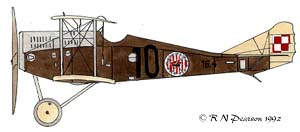 flown
in civil aerial competitions and shows by famous pilots, such as Arturo
Ferrarin and D'Urso. Some Balillas were flown by Polish pilots between
1920 and 1926, in the wars with the USSR and the Ukraine.
flown
in civil aerial competitions and shows by famous pilots, such as Arturo
Ferrarin and D'Urso. Some Balillas were flown by Polish pilots between
1920 and 1926, in the wars with the USSR and the Ukraine.
Only two original aeroplanes survive; one in the Caproni collection (s/n A-1 16552) and one preserved by the city of Bergamo, in the north of Italy (s/n A-1 16553). The latter machine, whose restoration is due to begin shortly, had been presented by the city of Genova to Ten. Antonio Locatelli, one of the most successful reconnaissance pilots of the war. This aircraft was flown at the front by Locatelli on September 1st, 2nd, 3rd and 9th, 1918, in reconnaissance missions over the Grappa and the Piave areas. Locatelli was shot down and captured on September 15th, 1918. This Balilla's last flight took place on the August 24th, 1920, when Locatelli, who had escaped from captivity in November 1918, flew it from Ghedi to Ponte S. Pietro. Shortly afterwards, the plane was presented by Locatelli to the city of Bergamo.
The Kit
The kit's contents comprises a sprue of fairly soft grey plastic parts, a sheet of photoetch containing materials for two wire wheels and cockpit interior, and a decal sheet for several versions, including Italian, Polish, Latvian and Soviet.
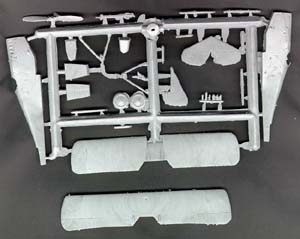 The
dimensions of the kit parts measure up well with the information available.
Some smaller details are missing, including some fuselage detail, and
the small, one-eighth chord ribs located at the wings' leading edge, positioned
between the full chord ribs. These omissions are minor, however, compared
to the missing detail on the underside of both wings and on both sides
of the horizontal and vertical tail parts. The underside of both wings
has the ailerons' detail but no rib detail whatsoever; the surface is
completely bald; similarly for the tail parts' surfaces. This a shame
since the upper wings detail is quite good, comprising a restrained amount
of rib surface detail. The task of detailing the lower wings' surface
is made easier by the presence of the scalloped trailing edges, whose
points show where the rib detail should be located. The missing rib detail
should be easy to add by scoring gently with a sharp X-acto knife, using
sticky tape, decal strips or whichever method you deem preferable.
The
dimensions of the kit parts measure up well with the information available.
Some smaller details are missing, including some fuselage detail, and
the small, one-eighth chord ribs located at the wings' leading edge, positioned
between the full chord ribs. These omissions are minor, however, compared
to the missing detail on the underside of both wings and on both sides
of the horizontal and vertical tail parts. The underside of both wings
has the ailerons' detail but no rib detail whatsoever; the surface is
completely bald; similarly for the tail parts' surfaces. This a shame
since the upper wings detail is quite good, comprising a restrained amount
of rib surface detail. The task of detailing the lower wings' surface
is made easier by the presence of the scalloped trailing edges, whose
points show where the rib detail should be located. The missing rib detail
should be easy to add by scoring gently with a sharp X-acto knife, using
sticky tape, decal strips or whichever method you deem preferable.
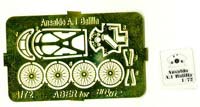 As
is the case with many short run kits, the molding is rough and contains
significant amounts of flash, however, spend a couple of evenings sanding
of the major parts, use some bamboo or aftermarket strut materials, and
you will have the basis of a decent kit. Some of the smaller detailed
parts; for example, wheels (if you do the solid ones) might benefit from
replacement with aftermarket items. The exhausts will also require careful
sanding or simply replacement with thin plastic rod. The kit also provides
some options for different versions; these include the wire or covered
wheels mentioned above, and a Latvian or Italian plate for the underside
of the front fuselage. Cockpit materials include a clear piece mounted
to a brass photoetch instrument panel and a seat, however, the builder
is given instructions to scratchbuild a cockpit floor and a control stick.
The instructions are a little difficult to read, comprising a single of
paper with a small font but the basics are present. None of the plastic
parts are numbered but there are sufficiently few so that is not a real
problem.
As
is the case with many short run kits, the molding is rough and contains
significant amounts of flash, however, spend a couple of evenings sanding
of the major parts, use some bamboo or aftermarket strut materials, and
you will have the basis of a decent kit. Some of the smaller detailed
parts; for example, wheels (if you do the solid ones) might benefit from
replacement with aftermarket items. The exhausts will also require careful
sanding or simply replacement with thin plastic rod. The kit also provides
some options for different versions; these include the wire or covered
wheels mentioned above, and a Latvian or Italian plate for the underside
of the front fuselage. Cockpit materials include a clear piece mounted
to a brass photoetch instrument panel and a seat, however, the builder
is given instructions to scratchbuild a cockpit floor and a control stick.
The instructions are a little difficult to read, comprising a single of
paper with a small font but the basics are present. None of the plastic
parts are numbered but there are sufficiently few so that is not a real
problem.
Recommendation
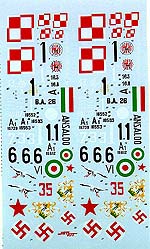 If
you want to build the Balilla, your alternatives are limited. In 1/72nd
scale, Joystick produced a vacuform kit and Toycraft Berg released a fairly
expensive resin kit. In 1/48th scale, Sierra Scale Models produces a vacuform.
If
you want to build the Balilla, your alternatives are limited. In 1/72nd
scale, Joystick produced a vacuform kit and Toycraft Berg released a fairly
expensive resin kit. In 1/48th scale, Sierra Scale Models produces a vacuform.
Without doubt, Hit Kit's product is rough; there is a lot of flash and a certain amount of work is required of the builder, not usually associated with an injection molded kit, in particular work on the surface detail on the wing and tailparts. Such are the limitations of many short run injection molded kits, but that's the downside.
There are, however, relatively few opportunities to build injection model kits of World War One Italian aeroplanes. Without this short run stuff, we would be building only the most popular items, so if you want a bit of variety in your life, you may have to put up with some inconvenience. This kit will not fall together nor does it possess the level of fine detail found in some higher end productions. If, however, you enjoy building somewhat unusual World War One subjects and do not mind a little work, you might enjoy this one.
The review kit was purchased from Ken LaSala of KPL Systems for $10.95.
Acknowledgement
My thanks to Alberto Casirati, who generously supplied the background historical notes on the Ansaldo A-1 'Balilla'. More photographs and details, can be found at this site. Any remaining errors are my own responsibility.

Previous: Contents








